5.2 – Laws and Regulations Associated with Selling and Distributing Seed
Understanding Seed Quality

Seed is a living entity, and improper handling can cause it to lose quality or even die. How seeds are harvested, transferred, and stored can all affect their viability, which is essential for farmers and global food security.
When someone buys or distributes seed, there are inherent expectations regarding:
- Germination Rate (Viability): What percentage of seeds in the lot will grow?
- Seed Type and Variety: Is the seed type and variety in the package accurately labeled?
- Contaminants: Are there unwanted materials like weed seeds, noxious weeds, soil, inert matter, insects, or diseases in the package?
These factors are crucial, and every country, including the U.S., has laws (like the U.S. Federal Seed Act) to ensure seed quality is communicated clearly to buyers at the point of sale or distribution.
It is impossible to tell if a seed is alive or dead without testing it through planting or lab analysis.
Objectives of Seed Laws
Federal, state, and international seed laws require all seed containers to have a tag or label indicating seed quality. For bulk sales, a special label called a “bulk certificate” is used. Government regulatory agencies enforce these labeling laws through:
- Testing for truth in labeling
- Collecting registration fees
Here is how federal and state laws work together to regulate seed:
- Federal Seed Act: Overseen by the USDA, this act applies when seeds are sold across state lines. It requires truthful labeling and conducts lab tests to ensure seed variety accuracy.
- State Seed Laws: When seeds are sold within a state, they must follow the regulations of that state’s Seed Act, such as paying licensing fees and meeting testing requirements.
For example, in Colorado, the seed law is governed by Colorado Revised Statutes (C.R.S. 35-27-101-127) and enforced by the Colorado Department of Agriculture (CDA). Companies selling or conditioning seed in Colorado must register and pay fees to fund these regulatory programs.

Purpose of Both Federal and State Seed Act
These laws aim to:
- Ensure truth in labeling.
- Prevent economic losses due to poor crop yields, low crop quality, and the spread of noxious weeds.
- Regulate labeling, labelers, and sellers of seed for planting.
Who Needs a Registration Permit?
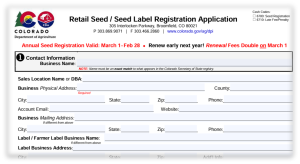
If you sell, label, or condition seeds, check each state’s requirements to see if you need a registration or permit. Typically, you need a permit if:
- Your company’s name is on the seed label (you are a seed labeler).
- You condition seed grown by someone else (you are a seed conditioner).
- You sell seed labeled by other companies (you are a retail seed dealer).
Seed Labels
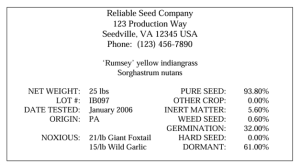
While the Federal Seed Act does not require registration for labelers, conditioners, or retailers, it sets important standards that influence all U.S. seed labeling laws and certification standards.
All seed sold, offered, or distributed in the U.S. must have a label that includes:
- Variety name and details: The type and variety of seed.
- Germination rate: The percentage of seeds expected to sprout.
- Contaminants: The presence of any unwanted substances, such as weed seeds or diseases.
Seed labels are critical—they inform buyers of the seed’s quality and help protect intellectual property. Mislabeling can lead to significant losses for farmers and could even impact food security.
This activity shows an example seed label. When clicking on each checkmark, you will learn more about that particular piece of required information.
Next, watch this 2 mins video by Rick Novak describing more about what is required on certified seed labels.
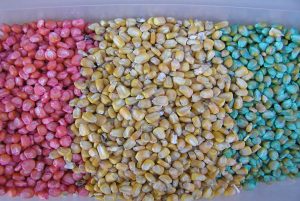
“Treated” Seed Labels
If seeds are treated (e.g., with chemicals for pest control), the label must include:
- The name of the treatment substance.
- The warning “DO NOT USE FOR FOOD, FEED, OR OIL PURPOSES.”
- If the treatment is poisonous, a skull and crossbones symbol is also required.
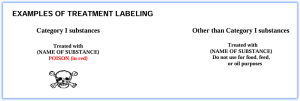
Template
Here is an example of a template label for common and certified seed. Certified seed labels are printed and provided to authorized growers via the Seed Certification Agency in each state. In Colorado, the Colorado Seed Growers Association (CSGA) is the Seed Certification Agency.
Prohibited Sale Conditions
Federal and state laws prohibit selling common seed if it contains:
- More than 2% weed seed by weight
- Prohibited noxious weed seed
- Restricted noxious weed seeds beyond allowable limits (specifics are found in federal or state Seed Acts).
Seed Distribution: Formal vs. Informal Sector
The seed industry is global. In the article, The role of national seed policies in re-structuring the seed sector in CEEC, CIS and other Countries in Transition – Michael Turner (fao.org), Turner separates defines two sectors:
- Formal Sector: Involves improved seed varieties developed through breeding and often protected by intellectual property. This includes both public institutions (e.g., universities) and private companies.
- Informal Sector: Common seed varieties not covered by patents or certification. These include heirloom seeds and seeds gathered from natural landscapes. Common seeds are freely traded and can be used without restrictions.
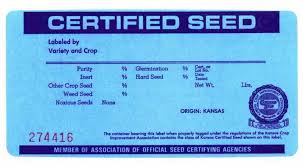
Regardless of sector, all seeds sold must include the same quality information on their labels. Certified seed meets specific standards, while common seed does not. The label helps identify which type of seed is in the container.
Required Records
All sellers and distributors must keep records of each seed lot, including:
- A representative sample file of each seed lot (kept for two years after sale or distribution).
- Invoices with details like lot number, variety, amount of seed sold, and buyer/seller information.
- A copy of the seed label.
- Test data used to create the labeling information.
Review
Work through these interactive questions to review the important concepts discussed.

Earn an industry recognized micro-credential at: CSU Upskill.
Seed that is alive; seed that can grow; containing structures and substances including enzyme systems that give it germination potential.
Undesirable plants classified by law as harmful to agriculture, natural habitats, or humans. Seeds of noxious weeds must be controlled in seed lots.
Non-seed material, such as dirt, stones, or plant debris, present in a seed lot.
Seed that is alive. Seed that can grow; containing structures and substances including enzyme systems that give it germination potential.
Seeds that, at the end of the test period, are neither hard nor dormant nor have produced any part of a seedling.

